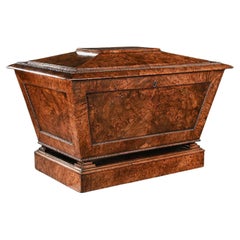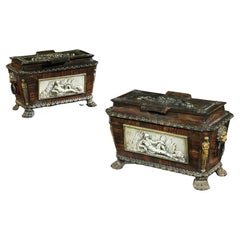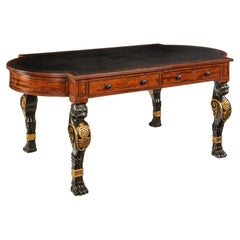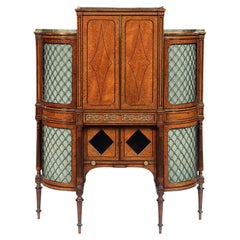Want more images or videos?
Request additional images or videos from the seller
1 of 11
Regency Mahogany Wine Cooler Cellarette of Sarcophagus Form
$4,756.21List Price
About the Item
- Dimensions:Height: 18.12 in (46 cm)Width: 29.93 in (76 cm)Depth: 19.1 in (48.5 cm)
- Style:Regency (Of the Period)
- Materials and Techniques:
- Place of Origin:
- Period:
- Date of Manufacture:circa 1820
- Condition:Wear consistent with age and use. A fine Regency wine cooler in exceptional original condition having finely chosen cuts of timber which mellowed to a wonderful natural colour.
- Seller Location:Benington, GB
- Reference Number:Seller: 27361stDibs: LU1183220855582
About the Seller
5.0
Gold Seller
Premium sellers maintaining a 4.3+ rating and 24-hour response times
Established in 1969
1stDibs seller since 2015
128 sales on 1stDibs
Typical response time: 5 hours
Associations
LAPADA - The Association of Arts & Antiques DealersThe British Antique Dealers' Association
Authenticity Guarantee
In the unlikely event there’s an issue with an item’s authenticity, contact us within 1 year for a full refund. DetailsMoney-Back Guarantee
If your item is not as described, is damaged in transit, or does not arrive, contact us within 7 days for a full refund. Details24-Hour Cancellation
You have a 24-hour grace period in which to reconsider your purchase, with no questions asked.Vetted Professional Sellers
Our world-class sellers must adhere to strict standards for service and quality, maintaining the integrity of our listings.Price-Match Guarantee
If you find that a seller listed the same item for a lower price elsewhere, we’ll match it.Trusted Global Delivery
Our best-in-class carrier network provides specialized shipping options worldwide, including custom delivery.You May Also Like
Antique Georgian Regency Mahogany Sarcophagus Shaped Wine Cellarette Cooler 1810
Located in Portland, OR
A fine and large antique Georgian Regency period mahogany wine cellarette, circa 1810.
This large cellarette is of sarcophagus shape and displ...
Category
Antique 1810s English Regency Dry Bars
Materials
Mahogany
$3,495
H 21 in W 29 in D 22 in
Antique Georgian Regency Flame Mahogany Sarcophagus Wine Cellarette Cooler 1820
Located in Portland, OR
A fine antique Georgian Regency flame mahogany wine cellarette or cooler, circa 1820.
The sacophagus shaped cellarette having a band of carved eplipital decoration to the top and a gadrooned edge to the hinged lid, the slanted paneled base is raised on a plinth base with corresponding gadrooning and the original brass casters.
To the inside is the original galvanized zinc...
Category
Antique 1820s English Regency Dry Bars
Materials
Zinc
$2,495
H 25.25 in W 22.25 in D 17.5 in
English Regency Mahogany Sarcophagus Shaped Wine Cooler
Located in Bedfordshire, GB
A fine quality regency perioid mahogany sarcophagus shaped wine cooler, or cellarette, retaining original brass carrying handles and fine colour throughout, raised on original plinth...
Category
Antique Early 19th Century English Regency Wine Coolers
Materials
Mahogany
Fine 19th Century English Regency Mahogany Cellarette
Located in Richmond, VA
Fine 19th century English regency carved mahogany cellarette with pinwheel foliate finial, hinged lid, carved medallions, fitted interior, bracketed paw feet on a stepped base.
Category
Antique 19th Century English Regency Dry Bars
Materials
Mahogany
Georgian Mahogany Wine Cooler / Cellarette
Located in Seaford, GB
Large George III Mahogany Cellarette / Wine Cooler – 18th Century Antique from Sussex
📜 Provenance – George III Mahogany Sarcophagus Cellarette, England, circa 1800
Sourced from a distinguished Sussex estate with longstanding ties to the Georgian period, this exceptional late 18th-century cellarette embodies the refined tastes of Regency-era English domestic design. Crafted circa 1800, the piece showcases rich, figured mahogany with a deep, lustrous patina developed over two centuries of continuous care and ceremonial use.
This cellarette was likely commissioned as part of a broader dining suite, intended to hold wines or spirits with both grandeur and discretion. Its form — inspired by Roman sarcophagi — reflects the classical influences prevalent in George III design. The original interior tin lining remains intact, a rare feature that underscores its authenticity and historical integrity.
Elevated on its original tapered legs and mounted with brass casters, the piece retains its original lion mask side handles, further articulating its status as a formal and functional object of significance. The substantial scale and sculptural quality allow it to serve equally as an antique wine cooler or statement console.
Evidence of a professional period repair to the top is visible and has been conserved to museum standards without compromising structure or surface character. The patina and minor wear are consistent with age and commensurate with a legacy object of this period.
This cellarette is not only an elegant storage solution but a collector's item of enduring design merit — ideal for connoisseurs of English Georgian furniture, fine wine enthusiasts, or interior designers seeking a historically anchored, investment-grade focal piece.
Large George III Mahogany Cellarette/ Wine Cooler is perfect for those discerning collectors of Georgian furniture or those seeking a unique antique wine storage solution. This Large George III Mahogany Cellarette / Wine Cooler is an exceptional find. This antique wine cooler, crafted around circa 1800, is made from richly figured mahogany and embodies the elegance of the Georgian period.
Inspired by the Roman Sarcophagus shape, this vintage wooden wine cooler combines practicality with timeless style, making it a statement piece for a country house or sophisticated interior.
Key Features of Large George III Mahogany Cellarette/ Wine Cooler:
Exceptional Craftsmanship & Design:
Made from high-quality mahogany with a deep, lustrous patina.
Inspired by the Roman Sarcophagus form, adding classical elegance.
Retains its original tin lining, a rare and valuable feature.
Spacious Antique Wine Storage:
Holds up to 15 bottles of wine or liquor securely.
Designed as a functional vintage wine chest for fine wine collectors.
Elegant Decorative Details:
Features patinated brass lion mask handles, adding a regal touch.
Raised on tapered legs ending in brass casters, making it easy to move even when fully stocked.
A stunning Georgian drinks cabinet that blends form and function effortlessly.
A Rare and Collectable Investment Piece:
An original George III period furniture piece with historical significance.
Ideal for collectors of 18th-century English cellarettes or antique wooden wine cabinets.
Suitable for luxury interiors, stately homes, or high-end wine cellars.
Perfect for Sussex-Based Antique Buyers & Collectors:
Available for purchase in Sussex – a hub for fine Georgian furniture dealers.
A classic English antique wine cooler for country house interiors in Sussex, Brighton, and the South East.
Easily complements other 18th-century furniture pieces, whether in West Sussex, East Sussex, or nearby London.
Condition Report: Large George III Mahogany Cellarette/ Wine Cooler
Age-related wear: Minor dings and scratches are expected in a 250-year-old Georgian wine storage chest.
Previous repair to the top, professionally restored to maintain integrity.
Structurally sound with an authentic patina, enhancing its historic charm.
Why Choose This George III Cellarette for Your Home?
Rare & Authentic: An original George III antique wine cooler, not a reproduction.
Functional & Decorative: Serves as both a practical wine storage solution and a luxurious antique drinks cabinet...
Category
Antique Early 19th Century English George III Dry Bars
Materials
Brass
19th Century Regency Wine Cooler Cellarette
Located in Folkestone, GB
A good quality and original 19th Century Regency period, figured mahogany, box-shaped wine cooler or cellarette.
The lifting lid opening to reveal a partitioned interior for storing...
Category
Antique Early 19th Century European Regency Dry Bars
Materials
Mahogany
Antique Sarcophagus Cellarette, English, Wine Cooler, Storage Case, Georgian
Located in Hele, Devon, GB
This is an antique sarcophagus cellarette. An English, mahogany wine cooler or storage case, dating to the Georgian period, circa 1780.
Excepti...
Category
Antique 1780s British Georgian Dry Bars
Materials
Brass
$6,917
H 19.49 in W 25.4 in D 19.69 in
Very Rare Regency Hardwood Cellarette of Sarcophagus Form Raised on Turned Legs
By Gillows of Lancaster & London
Located in West Sussex, Pulborough
We are delighted to offer for auction this exceptionally rare Regency Mahogany Cellarette of Sarcophagus form in solid mahogany on turned legs
A very good looking and well-made pi...
Category
Antique 1810s English Regency Dry Bars
Materials
Hardwood
$3,446
H 22.84 in W 16.93 in D 11.62 in
Regency Mahogany Sarcophagus Wine Cooler
Located in Martlesham, GB
A superb quality Regency mahogany sarcophagus wine cooler, having a lovely figured top which is decorated with ebony inlay, bold brass lion mask handles to the sides, a reeded apron ...
Category
Antique 1820s British Regency Cabinets
Materials
Mahogany
Regency Wine Cooler Sarcophagus Mahogany Chest
Located in Potters Bar, GB
Regency style mahogany wine cooler.
This wine cooler is of sarcophagus form.
circa 1930
Raised upon boldly carved lions paw feet.
The wine cooler f...
Category
Vintage 1930s Regency Commodes and Chests of Drawers
Materials
Mahogany
More From This Seller
View AllRegency Pollard Oak Sarcophagus Shaped Cellarette
Located in Benington, Herts
An Outstanding George IV Period Wine Cooler or Cellarette in Pollard Oak of Exceptional Colour and Patina
English - George IV, circa 1825.
This fine piece is of late regency/George...
Category
Antique 19th Century British Regency Wine Coolers
Materials
Oak
Extremely Rare Pair of Regency Cast-Iron Sarcophagus Shaped Strong Boxes
Located in Benington, Herts
An extremely rare pair of Regency cast-iron sarcophagus shaped strong boxes.
Regency, circa 1820
Painted to simulate palisander wood and with parcel-gilt, the cavetto-moulded hinged lids cast with flower sprays above foliate-cast bands over front panels relieved with river gods within canted corners cast with standing muses, the sides with lion mask and ring handles over leafy aprons on massive lion’s paw feet; the Brahmah type lock stamped “T. Davis from London” and impressed with the Royal Crown.
These extraordinary pieces are modelled on Regency wine coolers. The forms are classic Greco-Roman revival with the boat-hook handles, mythic figures and the overall sarcophagus pattern.
You would struggle to find one let alone a pair. Good items for any collection.
Research on going into these strong boxes but we have found possible information on the lock stamped Davis….(historyoflocks )
The relationship of King George III and George Davis of Windsor, who was locksmith in ordinary to His Majesty. Davis, in 1799, invented and patented a unique style of lock, which was also beautifully engraved with a warning not to make duplicate keys. Sensitive government secrets always demanded, then as today, locks that were state of the art. Davis locks ended up on government dispatch boxes...
Category
Antique Early 19th Century English Regency Commodes and Chests of Drawers
Materials
Iron
$21,954 Sale Price
35% Off
Important Regency Mahogany Partners Writing Table in the Manner of George Smith
By Charles Norman, George Smith
Located in Benington, Herts
A highly Important, Regency period mahogany, ebonised and parcel-gilt partners writing table on monopodia legs of exceptional quality and design, in the manner of George Smith, stamped Chas Norman, whom was associated with the work of Gillows.
Labelled ‘Morning Room’.
English, Regency period, circa 1810-20.
Rarely seen, the crescent shaped ended rectangular top, beautifully lined with the original gilt tooled leather writing surface, enclosed by a mahogany cross-banded border and reeded edge.
The frieze, containing four finely chosen fiddle-back mahogany drawers, two pairs to opposing sides, each retaining the original gadrooned carved ebonised knob handles. The perimeters having a finely ebonised cockbead, whilst the drawer liners being executed in mahogany retain the original recessed brass locks, which look to have never been removed. Flanking the drawers are bead-moulded ebonised panels which conform to either end above a reeded mould.
Raised on four boldly designed and imposing, crisply carved, ebonised and parcel-gilt leopard monopodia supports, of wonderful original waxed condition. The Egyptian leopards mask above a bold breast decorated with carved gilt anthemion and guilloche motifs, finishing on a finely detailed carved leg and paw foot.
The condition is excellent, retaining the original hand-dyed and gilt tooled waxed leather writing surface along with original locks, handles and ebonising with gilt-work to the legs. Commissioned for what presumes to be a private collection and due to its condition, being obvious to see, this writing table has been home to an important household. Labelled ‘Morning Library’ to the underside, whilst in this exemplary condition strongly suggests this striking piece of Regency furniture has furnished the library of the said house for the majority of its life.
As can be noted, this is an extremely rare, elegant, early Regency writing table of exceptional colour, which corresponds with designs of the celebrated furniture maker and designer George Smith, workmanship of Gillows, being stamped to the underside Chas Norman four times.
George Smith (1756 - 1826) was one of the most influential furniture designers of the English Regency Period (1811-1830). Smith, who began his pattern-book in 1804, wrote of ‘the great taste and elegance’ of this design.
In 1808 he published his influential and definitive text on Regency interior Design titled ‘ A Collection of Designs for Household Furniture and Interior Decoration’ and classed himself as ‘Upholder Extraordinary to His Royal Excellency the Prince of Wales’…The Prince Regent.
Smith was inspired in his designs from his earlier career as an Egyptologist, producing drawings incorporating motifs of Leopards heads and paws, Lions, sphinx’s, anthemia, and griffons amongst others.
Charles Heathcote Tatham (1772-1842) published ‘Etchings, Representing the Best Examples of Ancient Ornamental Architecture; Drawn from the Originals in Rome, and Other Parts of Italy During the Years 1794, 1795, and 1796’, in which he illustrated an antique tripod table...
Category
Antique Early 19th Century British Regency Desks and Writing Tables
Materials
Mahogany, Giltwood
$28,950 Sale Price
50% Off
Regency Amboyna And Ebony Inlaid Gilt Bronze Mounted Shaped Cabinet
Located in Benington, Herts
An early 19th Century Regency ormolu mounted amboyna and ebony shaped side cabinet on tapering legs. Outstanding quality.
In fine condition, the amboyna veneers having obtained a w...
Category
Antique 19th Century English Regency Cabinets
Materials
Ebony, Amboyna
Regency Amboyna and Brass Inlaid Gilt Bronze Mounted Pier Table
Located in Benington, Herts
An extremely elegant, rare Regency amboyna and brass inlaid gilt bronze mounted pier table. Provenance Part of Sir William Whitfield Collection.
English Regency period, Circa 1815.
The raised back with open shelf, surmounted by a pierced anthemion three quarter brass gallery above a rectangular mirror plate, flanked by gilt bronze pierced foliate scrolled supports, over a finely coloured amboyna and banded top above cut brass inlaid frieze drawer decorated with anthemion and flower head motif.
The dual tapering scroll supports with palmette lappet surmounts and cut brass inlay terminate on gilt bronze claw feet, flanking a later large mirror plate to the rear, raised on a inverted breakfront plinth base edged with gilt bonze beading. Formerly in the collection of Sir William Whitfield.
This elegant Regency pier table is a superb example with its fine quality mounts and distinctive amboyna veneers which are rarely found on furniture of this period.
The condition is excellent, having the most wonderful colour and patination to the finest cuts of amboyna that would have been available, during the early 19th century this veneer was thought to be worth more in its weight than gold.
This table would have almost certainly been especially commissioned, further research maybe undertaken to find a comparative example and insight to a potential maker.
As such pieces in amboyna are far rarer, an example of pier table has yet to be found, but an amboyna sofa table with extremely similar brass inlay and form can be seen in Clifford Musgrave’s book Regency Furniture, published by Faber and Faber in 1961, plate 63.
It is from the Royal Collection and the caption includes ‘made about 1816 for Clarement,’ (Claremont) ‘ Esher, Surrey, home of the Princess Charlotte...
Category
Antique 19th Century British Regency Vanities
Materials
Brass, Bronze
George III Mahogany Serpentine Tea Table of Exceptional Colour and Patination
Located in Benington, Herts
A Very Fine and Unusual George III Period Mahogany Serpentine Tea Table of Exceptional Colour and Patina
English c.1780
This fine table is a riot of serpentine curves. Broadly spe...
Category
Antique Late 18th Century English George III Tables
Materials
Serpentine
Recently Viewed
View AllMore Ways To Browse
Antique Wine Coolers And Cellarette
Regency Cellarette
Wine Sarcophagus
Wine Cooler Sarcophagus
French Antique Wine Cooler
Art Deco Champagne Cooler
Wine Cooler Italian Silver Plated
Italian Champagne Bucket
Antique Wine Coolers And Cellarette
Vintage 1949 Wine
Antique Wine Barrel
Brass Cellarette
Wine Cooler Stand
Gold Wine Cooler
Vintage Champagne Cooler
Regency Cellarette
English Cellarette
Antique Copper Wine Cooler



